Fanhua Shang
Beyond Background Shift: Rethinking Instance Replay in Continual Semantic Segmentation
Mar 28, 2025Abstract:In this work, we focus on continual semantic segmentation (CSS), where segmentation networks are required to continuously learn new classes without erasing knowledge of previously learned ones. Although storing images of old classes and directly incorporating them into the training of new models has proven effective in mitigating catastrophic forgetting in classification tasks, this strategy presents notable limitations in CSS. Specifically, the stored and new images with partial category annotations leads to confusion between unannotated categories and the background, complicating model fitting. To tackle this issue, this paper proposes a novel Enhanced Instance Replay (EIR) method, which not only preserves knowledge of old classes while simultaneously eliminating background confusion by instance storage of old classes, but also mitigates background shifts in the new images by integrating stored instances with new images. By effectively resolving background shifts in both stored and new images, EIR alleviates catastrophic forgetting in the CSS task, thereby enhancing the model's capacity for CSS. Experimental results validate the efficacy of our approach, which significantly outperforms state-of-the-art CSS methods.
iLLaVA: An Image is Worth Fewer Than 1/3 Input Tokens in Large Multimodal Models
Dec 09, 2024Abstract:In this paper, we introduce iLLaVA, a simple method that can be seamlessly deployed upon current Large Vision-Language Models (LVLMs) to greatly increase the throughput with nearly lossless model performance, without a further requirement to train. iLLaVA achieves this by finding and gradually merging the redundant tokens with an accurate and fast algorithm, which can merge hundreds of tokens within only one step. While some previous methods have explored directly pruning or merging tokens in the inference stage to accelerate models, our method excels in both performance and throughput by two key designs. First, while most previous methods only try to save the computations of Large Language Models (LLMs), our method accelerates the forward pass of both image encoders and LLMs in LVLMs, which both occupy a significant part of time during inference. Second, our method recycles the beneficial information from the pruned tokens into existing tokens, which avoids directly dropping context tokens like previous methods to cause performance loss. iLLaVA can nearly 2$\times$ the throughput, and reduce the memory costs by half with only a 0.2\% - 0.5\% performance drop across models of different scales including 7B, 13B and 34B. On tasks across different domains including single-image, multi-images and videos, iLLaVA demonstrates strong generalizability with consistently promising efficiency. We finally offer abundant visualizations to show the merging processes of iLLaVA in each step, which show insights into the distribution of computing resources in LVLMs. Code is available at https://github.com/hulianyuyy/iLLaVA.
Deep Correlated Prompting for Visual Recognition with Missing Modalities
Oct 10, 2024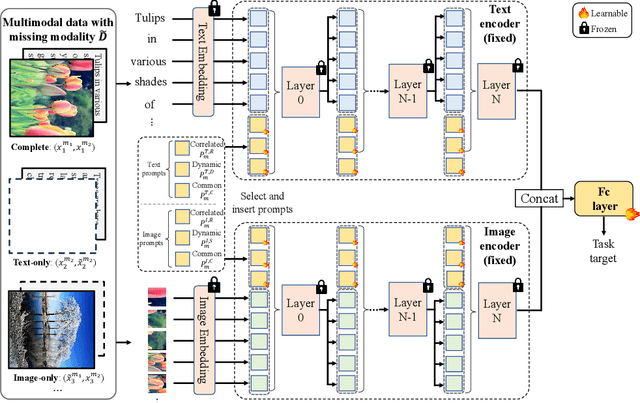

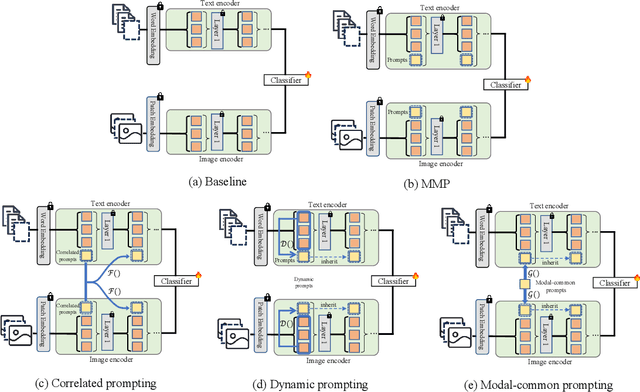

Abstract:Large-scale multimodal models have shown excellent performance over a series of tasks powered by the large corpus of paired multimodal training data. Generally, they are always assumed to receive modality-complete inputs. However, this simple assumption may not always hold in the real world due to privacy constraints or collection difficulty, where models pretrained on modality-complete data easily demonstrate degraded performance on missing-modality cases. To handle this issue, we refer to prompt learning to adapt large pretrained multimodal models to handle missing-modality scenarios by regarding different missing cases as different types of input. Instead of only prepending independent prompts to the intermediate layers, we present to leverage the correlations between prompts and input features and excavate the relationships between different layers of prompts to carefully design the instructions. We also incorporate the complementary semantics of different modalities to guide the prompting design for each modality. Extensive experiments on three commonly-used datasets consistently demonstrate the superiority of our method compared to the previous approaches upon different missing scenarios. Plentiful ablations are further given to show the generalizability and reliability of our method upon different modality-missing ratios and types.
Pose-Guided Fine-Grained Sign Language Video Generation
Sep 25, 2024

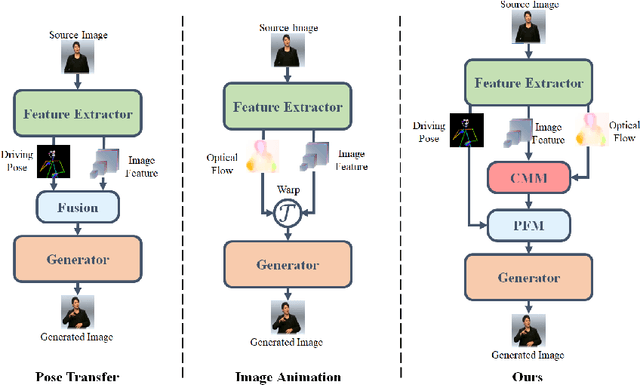

Abstract:Sign language videos are an important medium for spreading and learning sign language. However, most existing human image synthesis methods produce sign language images with details that are distorted, blurred, or structurally incorrect. They also produce sign language video frames with poor temporal consistency, with anomalies such as flickering and abrupt detail changes between the previous and next frames. To address these limitations, we propose a novel Pose-Guided Motion Model (PGMM) for generating fine-grained and motion-consistent sign language videos. Firstly, we propose a new Coarse Motion Module (CMM), which completes the deformation of features by optical flow warping, thus transfering the motion of coarse-grained structures without changing the appearance; Secondly, we propose a new Pose Fusion Module (PFM), which guides the modal fusion of RGB and pose features, thus completing the fine-grained generation. Finally, we design a new metric, Temporal Consistency Difference (TCD) to quantitatively assess the degree of temporal consistency of a video by comparing the difference between the frames of the reconstructed video and the previous and next frames of the target video. Extensive qualitative and quantitative experiments show that our method outperforms state-of-the-art methods in most benchmark tests, with visible improvements in details and temporal consistency.
Compensate Quantization Errors+: Quantized Models Are Inquisitive Learners
Jul 22, 2024Abstract:Large Language Models (LLMs) showcase remarkable performance and robust deductive capabilities, yet their expansive size complicates deployment and raises environmental concerns due to substantial resource consumption. The recent development of a quantization technique known as Learnable Singular-value Increment (LSI) has addressed some of these quantization challenges. Leveraging insights from LSI and our extensive research, we have developed innovative methods that enhance the performance of quantized LLMs, particularly in low-bit settings. Our methods consistently deliver state-of-the-art results across various quantization scenarios and offer deep theoretical insights into the quantization process, elucidating the potential of quantized models for widespread application.
Towards stable training of parallel continual learning
Jul 11, 2024Abstract:Parallel Continual Learning (PCL) tasks investigate the training methods for continual learning with multi-source input, where data from different tasks are learned as they arrive. PCL offers high training efficiency and is well-suited for complex multi-source data systems, such as autonomous vehicles equipped with multiple sensors. However, at any time, multiple tasks need to be trained simultaneously, leading to severe training instability in PCL. This instability manifests during both forward and backward propagation, where features are entangled and gradients are conflict. This paper introduces Stable Parallel Continual Learning (SPCL), a novel approach that enhances the training stability of PCL for both forward and backward propagation. For the forward propagation, we apply Doubly-block Toeplit (DBT) Matrix based orthogonality constraints to network parameters to ensure stable and consistent propagation. For the backward propagation, we employ orthogonal decomposition for gradient management stabilizes backpropagation and mitigates gradient conflicts across tasks. By optimizing gradients by ensuring orthogonality and minimizing the condition number, SPCL effectively stabilizing the gradient descent in complex optimization tasks. Experimental results demonstrate that SPCL outperforms state-of-the-art methjods and achieve better training stability.
Completed Feature Disentanglement Learning for Multimodal MRIs Analysis
Jul 06, 2024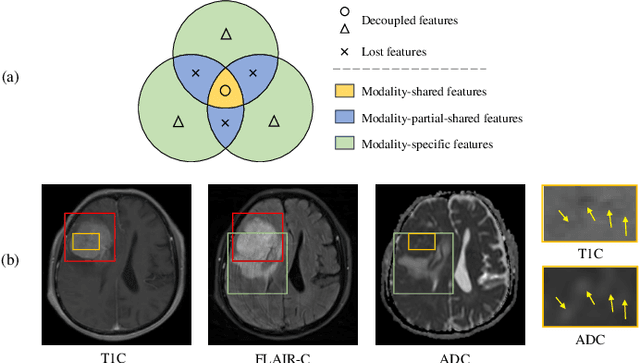
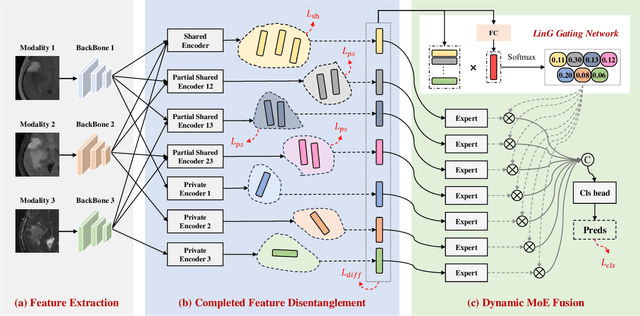
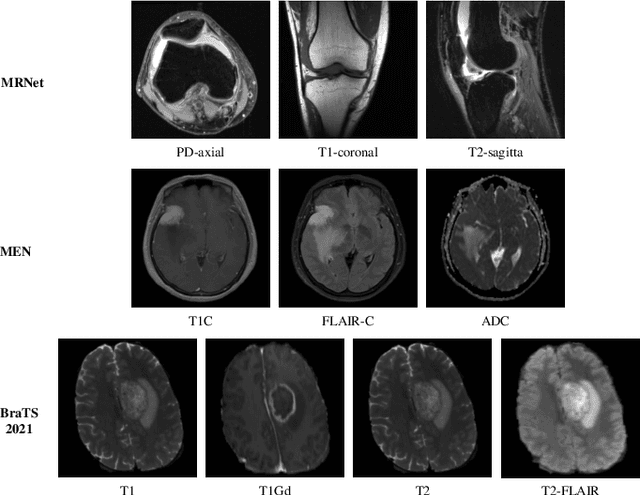
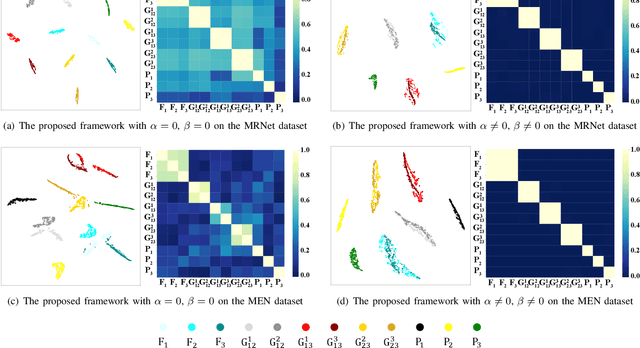
Abstract:Multimodal MRIs play a crucial role in clinical diagnosis and treatment. Feature disentanglement (FD)-based methods, aiming at learning superior feature representations for multimodal data analysis, have achieved significant success in multimodal learning (MML). Typically, existing FD-based methods separate multimodal data into modality-shared and modality-specific features, and employ concatenation or attention mechanisms to integrate these features. However, our preliminary experiments indicate that these methods could lead to a loss of shared information among subsets of modalities when the inputs contain more than two modalities, and such information is critical for prediction accuracy. Furthermore, these methods do not adequately interpret the relationships between the decoupled features at the fusion stage. To address these limitations, we propose a novel Complete Feature Disentanglement (CFD) strategy that recovers the lost information during feature decoupling. Specifically, the CFD strategy not only identifies modality-shared and modality-specific features, but also decouples shared features among subsets of multimodal inputs, termed as modality-partial-shared features. We further introduce a new Dynamic Mixture-of-Experts Fusion (DMF) module that dynamically integrates these decoupled features, by explicitly learning the local-global relationships among the features. The effectiveness of our approach is validated through classification tasks on three multimodal MRI datasets. Extensive experimental results demonstrate that our approach outperforms other state-of-the-art MML methods with obvious margins, showcasing its superior performance.
Controllable Continual Test-Time Adaptation
May 23, 2024



Abstract:Continual Test-Time Adaptation (CTTA) is an emerging and challenging task where a model trained in a source domain must adapt to continuously changing conditions during testing, without access to the original source data. CTTA is prone to error accumulation due to uncontrollable domain shifts, leading to blurred decision boundaries between categories. Existing CTTA methods primarily focus on suppressing domain shifts, which proves inadequate during the unsupervised test phase. In contrast, we introduce a novel approach that guides rather than suppresses these shifts. Specifically, we propose $\textbf{C}$ontrollable $\textbf{Co}$ntinual $\textbf{T}$est-$\textbf{T}$ime $\textbf{A}$daptation (C-CoTTA), which explicitly prevents any single category from encroaching on others, thereby mitigating the mutual influence between categories caused by uncontrollable shifts. Moreover, our method reduces the sensitivity of model to domain transformations, thereby minimizing the magnitude of category shifts. Extensive quantitative experiments demonstrate the effectiveness of our method, while qualitative analyses, such as t-SNE plots, confirm the theoretical validity of our approach.
Overcoming Domain Drift in Online Continual Learning
May 15, 2024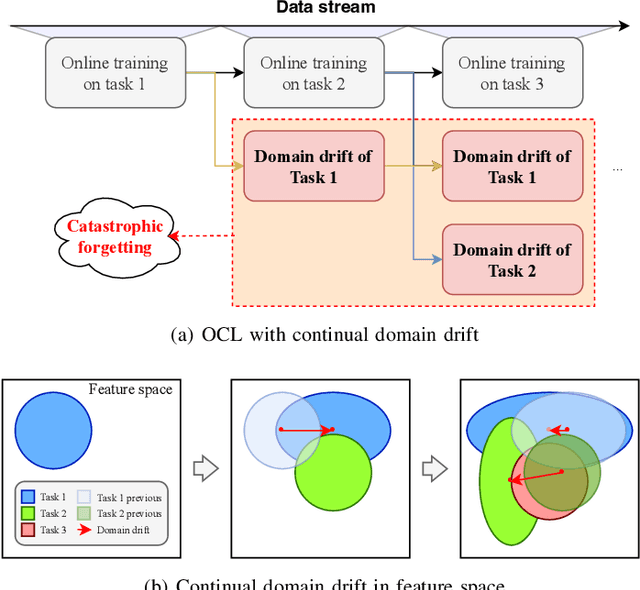

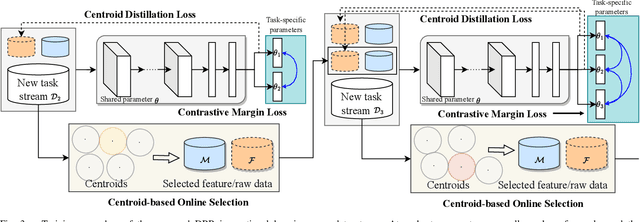
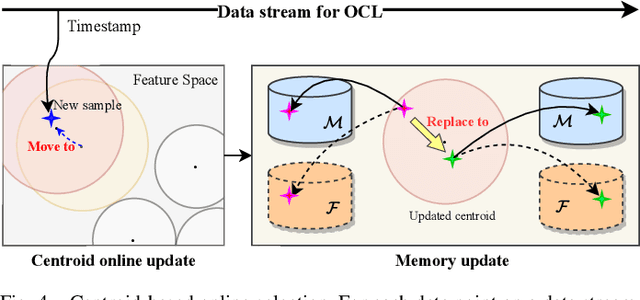
Abstract:Online Continual Learning (OCL) empowers machine learning models to acquire new knowledge online across a sequence of tasks. However, OCL faces a significant challenge: catastrophic forgetting, wherein the model learned in previous tasks is substantially overwritten upon encountering new tasks, leading to a biased forgetting of prior knowledge. Moreover, the continual doman drift in sequential learning tasks may entail the gradual displacement of the decision boundaries in the learned feature space, rendering the learned knowledge susceptible to forgetting. To address the above problem, in this paper, we propose a novel rehearsal strategy, termed Drift-Reducing Rehearsal (DRR), to anchor the domain of old tasks and reduce the negative transfer effects. First, we propose to select memory for more representative samples guided by constructed centroids in a data stream. Then, to keep the model from domain chaos in drifting, a two-level angular cross-task Contrastive Margin Loss (CML) is proposed, to encourage the intra-class and intra-task compactness, and increase the inter-class and inter-task discrepancy. Finally, to further suppress the continual domain drift, we present an optional Centorid Distillation Loss (CDL) on the rehearsal memory to anchor the knowledge in feature space for each previous old task. Extensive experimental results on four benchmark datasets validate that the proposed DRR can effectively mitigate the continual domain drift and achieve the state-of-the-art (SOTA) performance in OCL.
Elastic Multi-Gradient Descent for Parallel Continual Learning
Jan 02, 2024Abstract:The goal of Continual Learning (CL) is to continuously learn from new data streams and accomplish the corresponding tasks. Previously studied CL assumes that data are given in sequence nose-to-tail for different tasks, thus indeed belonging to Serial Continual Learning (SCL). This paper studies the novel paradigm of Parallel Continual Learning (PCL) in dynamic multi-task scenarios, where a diverse set of tasks is encountered at different time points. PCL presents challenges due to the training of an unspecified number of tasks with varying learning progress, leading to the difficulty of guaranteeing effective model updates for all encountered tasks. In our previous conference work, we focused on measuring and reducing the discrepancy among gradients in a multi-objective optimization problem, which, however, may still contain negative transfers in every model update. To address this issue, in the dynamic multi-objective optimization problem, we introduce task-specific elastic factors to adjust the descent direction towards the Pareto front. The proposed method, called Elastic Multi-Gradient Descent (EMGD), ensures that each update follows an appropriate Pareto descent direction, minimizing any negative impact on previously learned tasks. To balance the training between old and new tasks, we also propose a memory editing mechanism guided by the gradient computed using EMGD. This editing process updates the stored data points, reducing interference in the Pareto descent direction from previous tasks. Experiments on public datasets validate the effectiveness of our EMGD in the PCL setting.
 Add to Chrome
Add to Chrome Add to Firefox
Add to Firefox Add to Edge
Add to Edge